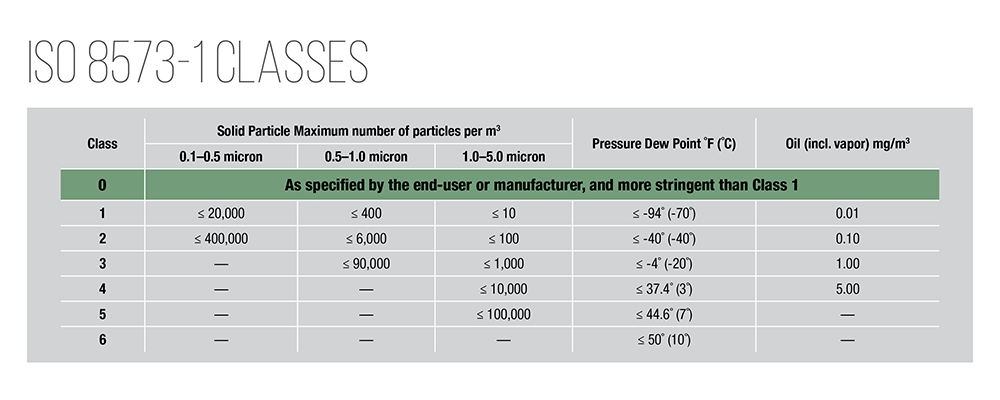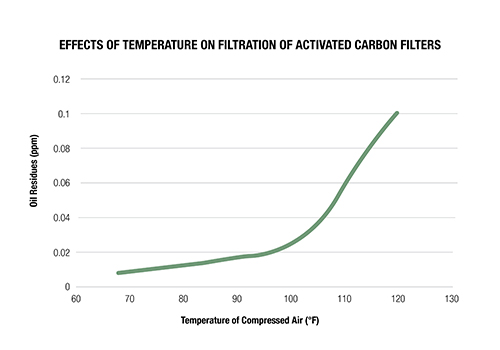
In the oil free rotary screw air compressor world, many terms are thrown around: oil free, Class 1, “technically oil free,” Class 0, Certified Class 0 and so on. While they may sound similar, there are many differences which should be understood, or the consequences of the wrong solution and technology can be devastating.
In this blog, we will focus specifically on Class 0 oil free air vs. Class 1, also called “technically oil free.” We will dive into the intricacies of Class 0 vs. “technically oil free” air and define the crucial differences between both classes. Let’s first establish a baseline of why oil free air is important to begin with.
There are certain industries and applications where the purity of compressed air is critical and requires the best quality of air to reduce the risk of contamination on compressed air, on the end product and other items throughout the production process. These industries include food and beverage, pharmaceutical, automotive, medical, electronic, labs, aerospace, semiconductors, refineries and chemical, to name a few.
Oil free air is critical in these industries because even the slightest amount of oil as a contaminant can have damaging effects—think contaminating end product, damaging production equipment, causing downtime or damaging your brand’s reputation due to the low quality of the end product and/or product rejections.
The International Organization for Standardization (ISO) 8573-1 Air Quality Classes outlines the contaminants allowed by class. Oil free applications require Quality Class 1 at minimum but preferably Class 0. This is because Class 0 is stable, but Class 1 is unstable. Class 1 requires inline filtration to eliminate the oil content coming from the compression process, and the filtration depends mainly on two variables that directly affect the performance of the filtration process: compressed air pressure and compressed air temperature/ambient temperature.
Class 0 air is more stringent than Class 1 (0.01 mg/m³ of oil as contaminant), as agreed upon between the manufacturer and the user. Class 0 is also the standard Sullair/Hitachi oil free compressors meet in our DSP Series, SRL Series, DS and Centrifugal lines.
In short, the lower the Class, the lower the concentration of oil contaminant is in the compressed air, and the lower the risk of other contaminants.

The ISO 8573-1 standard consists of purity classes for contaminants in compressed air: particles, water and oil. The ISO 8573-1 purity classes can be used to describe the quality of a compressed air system or to specify the required quality for a precise application.
For purposes of this blog we will focus only on oil as a contaminant.
 Class 1 air is achieved by using oil flooded air compressors with inline filtration to capture some of the oil passing downstream. Thus, Class 1 air can be thought of as “technically oil free” air.
Class 1 air is achieved by using oil flooded air compressors with inline filtration to capture some of the oil passing downstream. Thus, Class 1 air can be thought of as “technically oil free” air.
As an example, think about a 1000 cfm oil flooded machine. It releases about 14 gallons of oil downstream per year (at 86°F and 3 mg oil/m³ of carryover on oil separator). At minimum, three filters are needed to remove the oil, including activated carbon filtration for oil vapors – but this can be a risky and precarious proposition, and here’s why. The performance of inline oil filters decreases with the inlet temperature.
Downstream filters are specified at 68-70°F (20-21°C) of compressed air inlet temperature. This is a very precise situation. If this is not the case, the performance of filtration decreases exponentially at higher temperatures (see graph #2). Imagine what happens if your compressed air reaches 80°F or 100°F or more—and it can easily happen, as the compressed air temperature at outlet of the compressor is approximately 27°F over ambient temperature. Here is what happens: as the temperature increases, the potential of oil going downstream significantly increases. This means oil can get into your equipment and contaminate the end product, your production equipment and the environment.
Additionally, there are maintenance factors that should also be considered when using oil flooded compressors with filtration to achieve Class 1 “technically oil free” air. In addition to the risk of contamination, users should consider the work and costs associated with maintaining oil separators, in line oil filters, oil vapor filters and condensate treatment equipment including:

The lifespan of filters is short. If you consistently maintain 68-70°F (20-21°C), the activated carbon filters – which remove oil vapors up to 0.01 mg/m³ – will last approximately 1½ months (41 days); but with any temperature shifts to around 100°F, the lifespan of the activated carbon filter could be only about 90 hours (4 days).
Variation of temperature makes oil free Class 1 unstable and means air quality can easily jump from Class 1, or “technically oil free,” to Class 2 which doesn’t even qualify as oil free air! Yikes.
All this being said, Class 1 is not always technically oil free because the quality/performance of filtration depends on the temperature of the compressed air. The higher the temperature, the more the compressed air quality decreases. The compressed air can jump between Class 1 <--> Class 2 depending on the temperature.
Even under optimum conditions and with several layers of oil removal (inline filters), “technically oil free” solutions are no longer considered a best practice. This is because of the risk of instability of the quality of compressed air (jumping from Class 1 to Class 2 and vice versa), due to the performance of inline filters fluctuating with temperature.
As noted above, Class 0 is more stringent than Class 1 (or 0.01 mg/m³ of oil as contaminant).
Class 0 air is a safer solution than Class 1 because it is stable, doesn’t change with temperature and doesn’t require inline filtration to remove oil contamination coming from the compressor.
As the most stringent air quality class, Class 0 ensures that a compressor discharges compressed air free of oil aerosols, oil vapors or oil liquids coming from the compressor. Class 0 oil free compressors help eliminate potential contamination as no oil or lubricant is introduced into the air compression process.
Although Class 0 oil free air compressors may have a higher upfront cost, the costs outweigh the risks. Class 0 compressors are much safer for sensitive applications, such as food and beverage, pharmaceutical, electronics and medical. Class 0 certification lowers the risk of air contamination that can result in damaged products and significant losses in revenue, customer trust and tarnishing your brand.
No one can put a price on that.
In short, Class 0 meets the ISO 8573-1 requirements.
Certified Class 0 has been certified by an outside lab to ensure compliance with all Class 0 requirements. Essentially, Certified Class 0 is like an extra check on the air quality by a 3rd party.
There are many terms thrown around in the oil free rotary screw compressor world: from Certified Class 0, to Class 0, to “technically oil free," to Class 1. While they may sound similar, they have huge differences and can cause severe consequences if the wrong one is chosen. Today, we’ve outlined why oil free air is important to begin with, as well as the differences between Class 1 “technically oil free” air and Class 0 air.
A lot is on the line each day—the trust of your customers, your daily productions, downstream equipment, risk of downtime and your brand’s reputation. The stakes are too high to cut corners on your compressed air system. Using ISO 8573-1 certified Class 0 oil free air compressors helps improve your business operations and profitability by reducing your risks.
Use the checkboxes to select the types of cookies you want to accept, then press the “Save Settings” button. View our Privacy Policy.